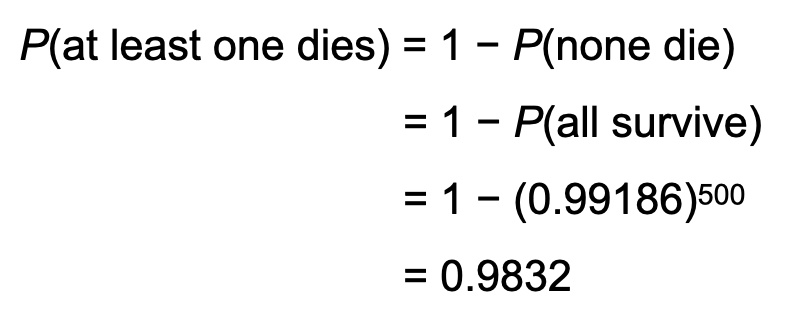5.3: Independence and the Multiplication Rule
Learning Objectives:
1. Identify independent events
2. Use the Multiplication Rule for Independent Events
3. Compute at-least probabilities
The Criteria: When is an Event independent or dependent?
Two events E and F are independent if..
the occurrence of event E in a probability experiment does not affect the probability of event F.
Two events are dependent if…
the occurrence of event E in a probability experiment does affect the probability of event F.
EXAMPLE Independent or Not?
Suppose you draw a card from a standard 52-card deck of cards and then roll a die. Are the events “draw a heart” and “roll an even number” independent or dependent?
Independent because the results of choosing a card do not impact the results of the die toss.
Suppose two 40-year old women who live in the United States are randomly selected. Are the events “woman 1 survives the year” and “woman 2 survives the year” independent or dependent?
Independent because
Suppose two 40-year old women live in the same apartment complex. Are the events “woman 1 survives the year” and “woman 2 survives the year” independent or dependent?
Independent because
Multiplication Rule for Independent Events
If E and F are independent events, then
EXAMPLE Computing Probabilities of Independent Events
The probability that a randomly selected female aged 60 years old will survive the year is 99.186% according to the National Vital Statistics Report, Vol. 47, No. 28.
What is the probability that two randomly selected 60 year old females will survive the year?
The survival of the first female is independent of the survival of the second female. We also have that P(survive) = 0.99186.
EXAMPLE Computing Probabilities of Independent Events
A manufacturer of exercise equipment knows that 10% of their products are defective. They also know that only 30% of their customers will actually use the equipment in the first year after it is purchased.
If there is a one-year warranty on the equipment, what proportion of the customers will actually make a valid warranty claim?
We assume that the defectiveness of the equipment is independent of the use of the equipment. So,
Multiplication Rule for Multiple (n) Independent Events
If E1, E2, E3, … and En are independent events, then
EXAMPLE Illustrating the Multiplication Principle for Independent Events
The probability that a randomly selected female aged 60 years old will survive the year is 99.186% according to the National Vital Statistics Report, Vol. 47, No. 28.
What is the probability that four randomly selected 60 year old females will survive the year?
P(all 4 survive) is P(1st survives and 2nd survives and 3rd survives and 4th survives)
= P(1st survives) • P(2nd survives) • P(3rd survives) • P(4th survives)
= (0.99186) (0.99186) (0.99186) (0.99186)
= 0.9678
“At least” Rule for Probabilities
calculate the probability of the complementary event (i.e., the event occurring zero times) and then subtracting that value from 1.
P(at least one event) = 1 - P(none of the events)
EXAMPLE Computing “at least” Probabilities
The probability that a randomly selected female aged 60 years old will survive the year is 99.186% according to the National Vital Statistics Report, Vol. 47, No. 28.
What is the probability that at least one of 500 randomly selected 60 year old females will die during the course of the year?




